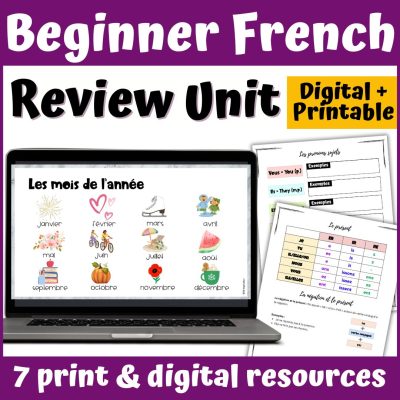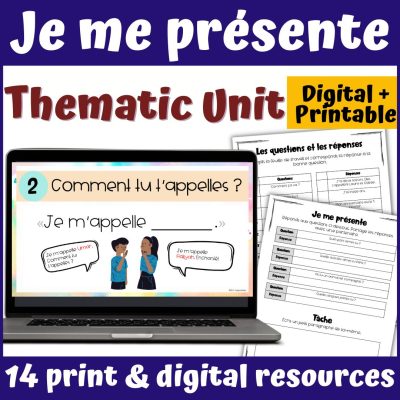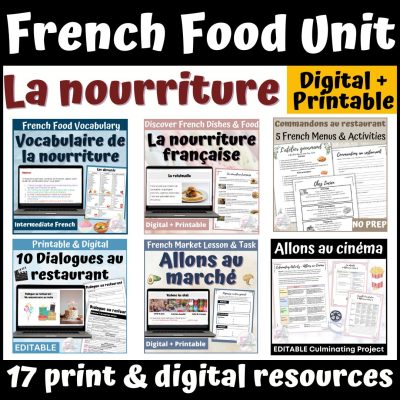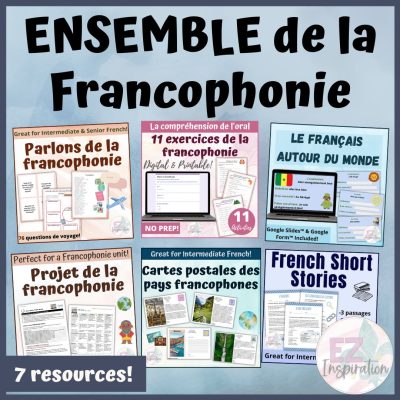
It’s no secret that Core French can be difficult to teach to FSL students. As French teachers we deal with unique challenges in fostering language acquisition and one key challenge lies in maintaining students’ interest and engagement. To address this challenge, especially in the context of de-streamed French classes, it is crucial to design engaging and authentic units that cater to the diverse needs and interests of our students. Creating units that incorporate real-world applications, cultural relevance, and student-centered activities, ensures that language learning goes beyond the conventional curriculum and becomes a dynamic and personalized experience for each student.
This blog post will highlight the 5 essential units that I use with my grade 9 Core French students that are high-interest and motivating topics that engage my learners and have them excited about the French language.
I always start the semester with a French beginner review unit. Many of my students come from a variety of different elementary schools with varying prior knowledge and confidence in French. Therefore, I like to review the essentials (ex. Les nombres, la météo, les couleurs, le présent, etc.) so that all students are on the same page and ready to tackle the more in-depth intermediate curriculum.
I usually keep this unit short to revisit important foundational concepts, strengthen basic skills, and acquire an overview of the strengths and weaknesses of my students. This unit helps me plan for the rest of the semester with my students.
By the end of this unit, students should ideally be able to:
-
- Understand the French number system (1-100)
- Recite the days of the week, the months of the year and the four seasons in French
- Be able to explain the weather in French
- Describe the color of a variety of objects in French
- Describe clothing, accessories and clothing material in French
- Differentiate between the different subject pronouns and use them correctly in a variety of contexts in French
- Know how to conjugate regular French verbs in the present tense
- Conjugate the four essential irregular French verbs in the present tense (Avoir, Être, Faire et Aller)
Next, this introductory French unit is important for establishing a strong foundation for communication. Students learn basic greetings, introductions, and expressions to confidently navigate real-life situations. They also acquire essential vocabulary and grammar skills to enable them to engage in basic conversations, learn to ask and answer questions about personal information, and describe themselves and others.
I usually aim for this unit to be one month and incorporate a variety of engaging activities that provide a real-life application. This French unit is also the perfect module for building a strong classroom environment as students will get to meet their peers and engage in simple French conversations.
By the end of this unit, students ideally should be able to:
-
- Introduce themselves and others
- Provide personal information (name, age, nationality, etc.)
- Ask and answer basic questions about personal details
- Describe physical appearances and personality traits
- Use common greetings and polite phrases in French
This is one of my students’ favorite French units of the year for de-streamed French! In this immersive French food unit, students embark on an engaging gastronomy adventure to explore French cuisine, recipes, menus, food-specific vocabulary, and more.
This is a high-interest topic because students LOVE food and the topic has relevance to their everyday lives. Learners like to discuss their favorite dishes and preferences along with completing creative and hands-on activities.
The best part is that there are so many different ways that you can teach this unit to students that offer a versatile and dynamic context for language acquisition. For example, every semester my students participate in a cheese tasting event. I purchase a variety of traditional French cheeses (ex. camembert, roquefort, comté, chèvre, reblochon, etc.) and bring them into class for students to try. They receive a handout with all the different cheeses and rate them on a scale of 1 (the worst) to 5 (the best). At the end of the cheese tasting event, I reveal the cheese that won. My students get so invested and root for a certain cheese to win. I’m looking forward to running this cultural event again this year in my classes!

By the end of this unit, students ideally should be able to:
-
- Read a French menu
- Order a meal at a restaurant in French
- Describe a meal using their senses in French
- Identify food that is healthy and unhealthy
- Explore traditional French dishes
- Give their opinion about a restaurant experience
- Follow a French recipe
- Debunk some myths related to food
- Use idiomatic expressions related to French in an authentic context
- Ask and answer a variety of questions related to food and their preferences
One disclaimer I have about this unit is that when showing visuals about food in class, be prepared for your students’ tummies to grumble and mouths to water. This is a hard unit to teach to a class that has French class right before lunch time!
A cinema unit is another engaging French unit for Intermediate students. Students LOVE to watch movies and will often list off their favorite Netflix shows, films, and actors with enthusiasm. This unit not only taps into their natural interest but also provides a unique opportunity to immerse themselves in the French language and culture.
There are also a lot of rich activities that you can do to further enhance this French unit. I have arranged group discussions and debates on film-related topics and have had students write a movie critique on a French film that we watched in class. Students also enjoy watching movie trailers for French films with English subtitles and role-playing scenarios like inviting a friend to the movies.
By the end of this unit, students ideally should be able to:
-
- Identify a variety of movie genres
- Describe a movie using different adjectives
- Talk about their favorite actors
- Identify the target audience for a variety of movies
- Analyze French movie trailers
- Use inference skills to make predictions about a movie’s plot
- Order food at the movie theater
- Invite a friend to the movies
- Critique a film (positively or negatively)
- Ask and answer general questions about movies
Within our Ontario French curriculum, French culture is the focus of every grade from 4-12. In grade 9, the curriculum strictly focuses on French culture in the francophone countries within Africa and Asia. I teach la francophonie as a stand-alone unit in grade 9 but also acknowledge that many teachers embed it throughout their semester and units of study. I do that as well, but also like to incorporate an extensive understanding of la francophonie and further develop students’ intercultural awareness and appreciation for the diversity of the French-speaking world in a standalone French unit.
Once again, there are many different avenues that you can take when planning this French unit. However, it is important to highlight different French-speaking countries and regions around the world. Students should also understand the importance of the French language, why so many people speak it around the world, and the various contributions made to la francophonie and the world.
By the end of this unit, students ideally should be able to:
-
- Identify different francophone countries in Africa and Asia
- Understand why French is spoken in so many countries around the world
- Examine different French words and expressions used in francophone countries around the world (especially in Africa and Asia)
- Compare and contrast a francophone country (in Africa and Asia) to their own
- Recognize different cultural symbols and artifacts related to French culture
- Understand and use French vocabulary related to different francophone regions, French culture, and travel
- Present about a francophone country and share about its cultural diversity and tourist locations
The 4 strands in De-streamed French
When developing your French units, it is important to include a variety of French speaking, listening, writing, and reading activities. These are the four modalities that help enhance French proficiency. Having daily exposure to these four strands is crucial for your student’s success and will help boost their confidence in French learning.
Grammar in Context
You will also want to teach grammar in context. If students are able to see the authentic usage of French grammar, they are more likely to retain these concepts and use them in their daily lives. In grade 9 Core French, I like to go over the following grammatical concepts with my intermediate students:
-
- Les pronoms sujets (review)
- Le présent (review)
- Les adjectifs
- Faire vs. Jouer
- Les articles
- Le passé composé avec avoir
- Le passé composé avec être
- Le futur simple
- Les verbes pronominaux et les routines quotidiennes
- La formation des questions
Additional Resources for De-streamed French
In closing, one of my favorite parts of teaching is planning engaging French resources for my students. However, I know that some teachers despise this part of teaching. If you want to eliminate hours and hours of prep, consider my intermediate French curriculum that I designed specifically for de-streamed grade 9 French. This curriculum includes all of the above units previously mentioned and a variety of speaking, reading, listening and writing activities to help your students excel in French. This bundle is 40% off the regular price, which means that you are getting at least two of the units for FREE! Have any questions? Never hesitate to reach out!
All the best with your planning and let’s inspire and engage our intermediate French learners!






